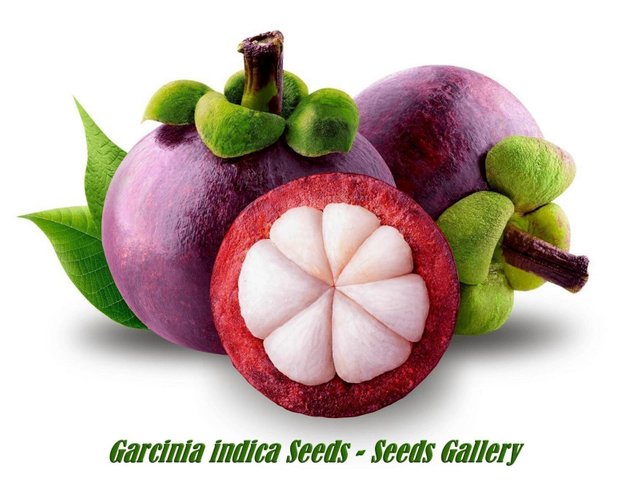Mangostad and its benefits
source

The mangosteen is an evergreen tree up to 25 m high, with a pyramidal crown and a brown-black bark. The leaves are oval-oblong, dark green above and yellow green below, 9-25 cm long and 4.5-10 cm wide. The young leaves are pink. Flowers with green fleshy petals with red spots.
The fruit is round, with a diameter of 3.4 - 7.5 cm, covered at the top with an inedible garnet-colored (up to 1 cm) violet garnet, containing sticky dye latex, containing 4-8 segments of white edible pulp with very tight seeds. The plant bears fruit late: the first fruits of the trees during 9 to 20 years of life. The homeland of the mangosteen is Southeast Asia. Widely cultivated in Thailand, Myanmar, Vietnam, Cambodia, Malaysia, India, Sri Lanka, the Philippines, the Antilles, Central America, Colombia, tropical Africa. Oddly enough, but in nature the mangosteen is not found, it is known only as a natural cultivar. It is believed that this is just a whim of nature, a natural hybrid of two related species (Garcinia malaccensis and Garcinia hombroniana), an aromatic polyploid that morphologically combines the qualities of both parents.
The name "polyploid" means a hereditary change associated with a multiple increase in the major number of chromosomes in the cells of the body. Polyplody is widespread in plants. In general, polyploid plants have larger sizes, higher content of several substances, better resistance to adverse environmental conditions. But here is the main secret of the queen of fruits: the mangosteen is asexual: in this plant, the reproduction takes place without the interposition of the male cells, all the flowers are both male and female, capable of self-fertilizing.
This very rare phenomenon of nature is called parthenogenesis. The nectar, which attracts natural pollinators, does not form in its flowers, therefore, during flowering, our queen remains in splendid isolation: insects and birds do not even cause a simple courtesy visit. A good mangosteen must be large and dense to the touch, but nevertheless jumps slightly when pressed gently on the fruit. Do not take small fruits, as they contain less pulp. Fruits, hard to the touch, dry, with cracked skin, already ripe. In a circular motion, cut the mangosteen from above, try not to touch the meat. You can make cuts on the sides and bottom of the fruit, after which the skin is removed with care. The mangosteen can be stored in the refrigerator for one or two weeks.
Mangosteen is a true source of the most important elements for humans: vitamins C and E, riboflavin, thiamin, nitrogen, calcium, magnesium, zinc, sodium and potassium. And at the same time, it has a very low level of acid-base balance (pH), only 3.2. Thai people eat raw mangosteen, as well as on the "bed" of crushed ice. In this way, the mangosteen has a very refreshing flavor, especially after hot and spicy foods. From the mangosteen, you can make a filling for cakes, add this fruit to spicy and fruit salads, smoothies, cook from the pulp of a mangosteen souffle, as well as curry fish sauces.
The light and sophisticated taste of mangosteen goes well with seafood, especially with squid and shrimp. For medical purposes, mangosteen is used for diarrhea. The meat left in the peel is peeled, boiled and prepared from this healing tea. Alternatively, the pulp can be baked, soaked in water and added to the mash, which must be done every two hours. Mangosteen is very rich in calcium, phosphorus and vitamins B and C. Mangosteen used and pharmacology. Practically everyone knows the antioxidant properties of vitamins C and E, but much less people are aware of the incredible possibilities of xanthones, natural chemicals that scientists recently discovered. A careful study of the medical capabilities of xanthones revealed the following pharmacological properties: Maintain microbiological balance; Protection of the immune system; Increase the general adaptability of the organism to the external environment; Ensuring good mental activity.
But the most interesting thing is that not only the internal pulp, but all the fruit as a whole, remains the only known source of this substance: a representative of a new generation of strong phytonutrients, which have not yet changed the future of the supplements dietetics And recently, the mangosteen juice, called "XanGo", has appeared in the world markets, it is recommended to drink it to maintain good health and a quick recovery from diseases and serious operations. Studies are being done on the possible beneficial effects of xanthones in the treatment of cancer.
According to scientific data, the xanthones contained in the mangosteen can affect the blood's coagulation. Therefore, doctors do not recommend that people who take anticoagulant medications eat these fruits. Allergic reactions to mangosteen and individual intolerance to fruit are also possible.
Beautifully crafted publication, Mangosteen is a true source of the most important elements for humans: vitamins C and E, riboflavin, thiamin, nitrogen, calcium, magnesium, zinc, sodium and potassium.
Resteem